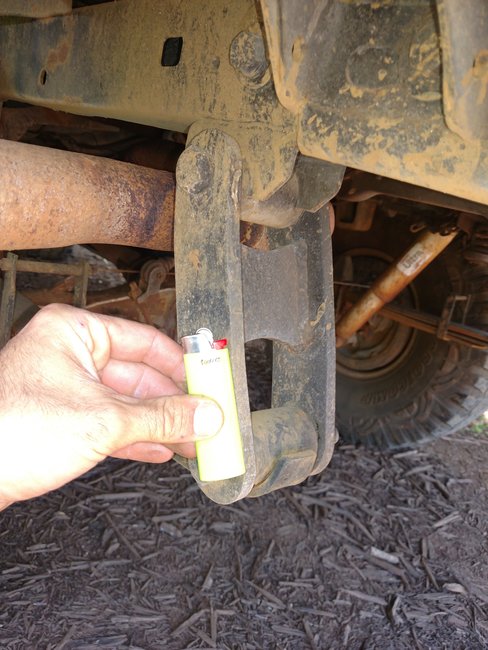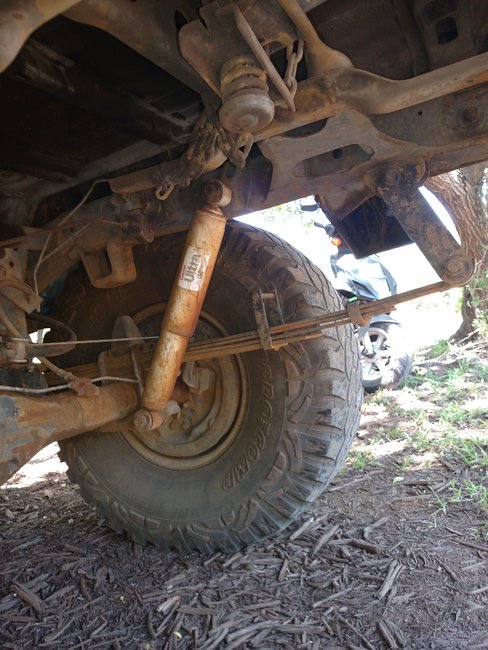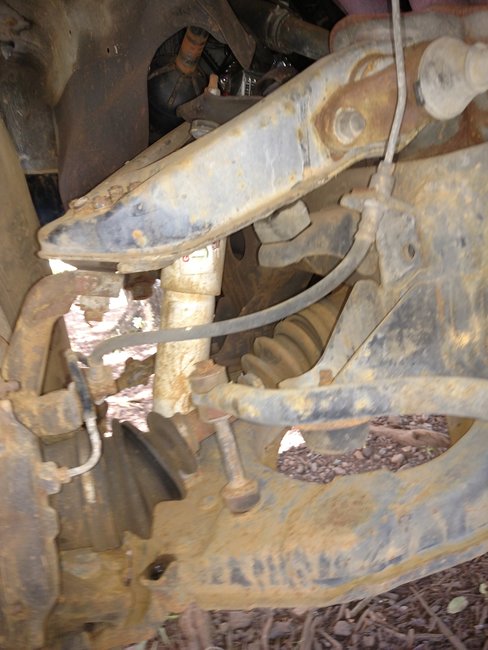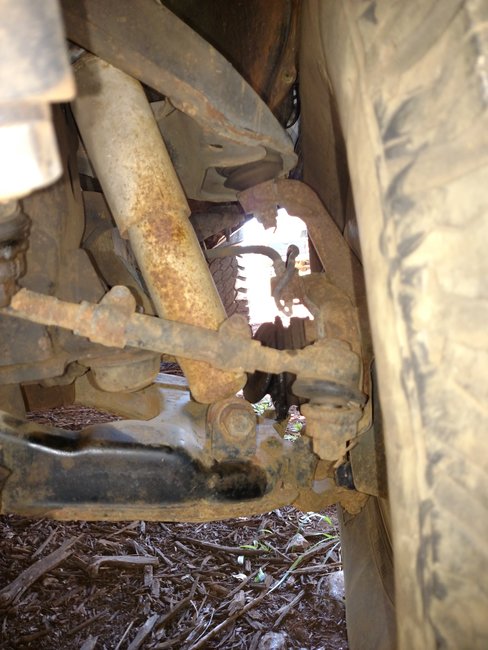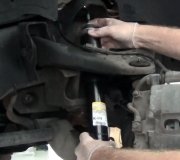Friday, March 31st, 2017 AT 3:11 PM
Lift size/type?
5 Replies
As a suspension and alignment specialist, I would never alter the ride height of any vehicle, including lowering cars. There are just too many things that could land me in a lawsuit. That said, there are different ways of raising a truck. If "drop spindles" are used, that raises the entire truck but it has no effect on the suspension geometry. This would be similar to parking it with the tires on 2" x 4"s laying on the ground. You'd have to step higher to get in, but the suspension hasn't changed. In that case, you'd use the standard shock absorbers that were originally used.
Unfortunately, most aftermarket lift kits raise trucks by pushing the wheels down. That stresses the suspension parts and rubber bushings, and has a serious negative effect on braking, handling, and steering response. (That's where becoming party to a lawsuit comes in). There is a limit as to how far you can go before other problems occur. The rear shock absorbers on your truck are what limits how much the axle housing can drop. They are what holds the axle up when the truck is on a hoist. In your case the leaf springs do that too, but without the shock absorbers in place, the rubber brake flex hose takes over that job. The angle changes the universal joints go through become grater too. That will increase wear and reduce their life. As the angle increases more, a high-frequency vibration will develop. With even higher lift, the universal joints will bind and not want to rotate freely.
In the front, the steering linkage must be perfectly parallel to the ground when the truck is at static ride height, meaning standing still. Also, there is a limit as to the angle the half shafts can be to the inner CV joint housing. If the angle is exceeded, the shaft will bang against the housing three times per wheel revolution. That will forcibly turn the steering wheel out of your hands. You get closest to that limit of travel when the truck raises up after going over a bump in the road. You also reach the maximum limit when running it in gear, on a hoist. It again is the shock absorber, and the rubber bump stops, that limit that travel.
My reason for describing this is to explain why you may not have non-standard shock absorbers. If the suspension geometry was never altered, you simply buy replacement shock absorbers listed for your application.
I suspect you have front torsion bars. Those are real easy to crank up to raise ride height. You can see in your last photo, (thank you for including them), the outer tie rod end is already at a huge angle and will bind if the body raises up much more. Also, the upper control arm is at a wild angle and will pull the top of the wheel in and out a real lot as the truck moves up and down, compared to what was designed in. That is going to cause greatly-accelerated tire wear, and the reduced handling and comfort I mentioned. Regardless of all the negative effects, you still must limit suspension travel to prevent damage to the inner CV joints. There is no practical way to change the half shaft angle to reduce it, so even though the suspension geometry has changed, it still can't be allowed to travel beyond its limit. That limit is set by the shock absorber. To say that in easier-to-understand terms, you need to continue using the shock absorbers called for.
Take an old front and rear shock absorber along to the auto parts store so you can match the lengths to the new ones. Sometimes the new ones will have a slightly longer or shorter stroke because the manufacturer already had something in production for a different vehicle, and it is close enough to work for yours. That difference in collapsed or extended length should typically not be more than about a half inch compared to the original parts, but be sure those limits of travel are greater. If the replacement doesn't extend quite as far, or it doesn't collapse quite as far, it could bottom out at the extreme end of its travel. In severe conditions that can tear it apart or damage the piston. A shock absorber that bottoms out can make for a very uncomfortable ride.
Unfortunately, most aftermarket lift kits raise trucks by pushing the wheels down. That stresses the suspension parts and rubber bushings, and has a serious negative effect on braking, handling, and steering response. (That's where becoming party to a lawsuit comes in). There is a limit as to how far you can go before other problems occur. The rear shock absorbers on your truck are what limits how much the axle housing can drop. They are what holds the axle up when the truck is on a hoist. In your case the leaf springs do that too, but without the shock absorbers in place, the rubber brake flex hose takes over that job. The angle changes the universal joints go through become grater too. That will increase wear and reduce their life. As the angle increases more, a high-frequency vibration will develop. With even higher lift, the universal joints will bind and not want to rotate freely.
In the front, the steering linkage must be perfectly parallel to the ground when the truck is at static ride height, meaning standing still. Also, there is a limit as to the angle the half shafts can be to the inner CV joint housing. If the angle is exceeded, the shaft will bang against the housing three times per wheel revolution. That will forcibly turn the steering wheel out of your hands. You get closest to that limit of travel when the truck raises up after going over a bump in the road. You also reach the maximum limit when running it in gear, on a hoist. It again is the shock absorber, and the rubber bump stops, that limit that travel.
My reason for describing this is to explain why you may not have non-standard shock absorbers. If the suspension geometry was never altered, you simply buy replacement shock absorbers listed for your application.
I suspect you have front torsion bars. Those are real easy to crank up to raise ride height. You can see in your last photo, (thank you for including them), the outer tie rod end is already at a huge angle and will bind if the body raises up much more. Also, the upper control arm is at a wild angle and will pull the top of the wheel in and out a real lot as the truck moves up and down, compared to what was designed in. That is going to cause greatly-accelerated tire wear, and the reduced handling and comfort I mentioned. Regardless of all the negative effects, you still must limit suspension travel to prevent damage to the inner CV joints. There is no practical way to change the half shaft angle to reduce it, so even though the suspension geometry has changed, it still can't be allowed to travel beyond its limit. That limit is set by the shock absorber. To say that in easier-to-understand terms, you need to continue using the shock absorbers called for.
Take an old front and rear shock absorber along to the auto parts store so you can match the lengths to the new ones. Sometimes the new ones will have a slightly longer or shorter stroke because the manufacturer already had something in production for a different vehicle, and it is close enough to work for yours. That difference in collapsed or extended length should typically not be more than about a half inch compared to the original parts, but be sure those limits of travel are greater. If the replacement doesn't extend quite as far, or it doesn't collapse quite as far, it could bottom out at the extreme end of its travel. In severe conditions that can tear it apart or damage the piston. A shock absorber that bottoms out can make for a very uncomfortable ride.
Was this helpful?
Yes
No
Friday, March 31st, 2017 AT 3:55 PM
Thank you for the detailed response, pure gold for anyone interested in lifts and suspension! I'm more interested in a "you have a 3" lift" kind of answer since I'm just interested in replacing the shocks and want to make sure I'm getting the right size shocks for whatever size lift I have. I included a full size bic lighter as a measuring tool, any guesses? Thanks again!
Was this helpful?
Yes
No
Saturday, April 1st, 2017 AT 3:35 PM
You're going to have to match the new ones to the old ones. As I pointed out, even though the suspension is extended, there are still limiting factors as to how much more it can go, and those limits are set, in part, by the shock absorbers. I'm pretty sure you're going to find your old shocks match the new ones called for. If you do indeed need something longer, and there's no part number to look at on the old ones, the parts stores will have cross reference books that include a section that lists their products by mounting style, and then by length. That is where you'll be able to match a new one to the old one.
Often the old part number is stamped on the housing, near the bottom. They're on stickers too, but those fall off over time.
Often the old part number is stamped on the housing, near the bottom. They're on stickers too, but those fall off over time.
Was this helpful?
Yes
No
+1
Saturday, April 1st, 2017 AT 3:50 PM
Related Suspension Shock Replace/Remove Content

Front Shock Absorbers Ford F-150
Instructional repair video

Shock Replacement (Air) Mercedes Benz

Shock Replacement - Front

Front Shock Absorbers Ford F-150
